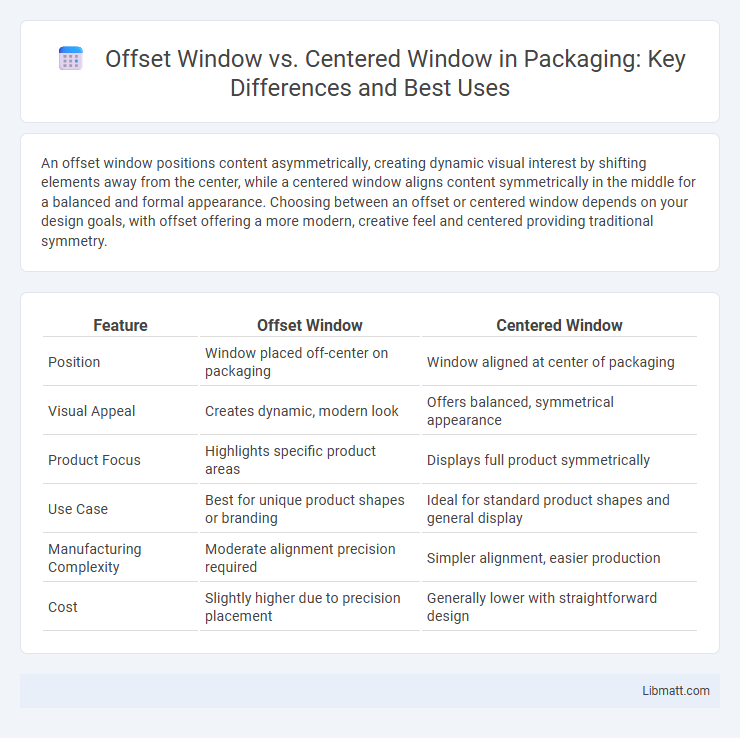An offset window positions content asymmetrically, creating dynamic visual interest by shifting elements away from the center, while a centered window aligns content symmetrically in the middle for a balanced and formal appearance. Choosing between an offset or centered window depends on your design goals, with offset offering a more modern, creative feel and centered providing traditional symmetry.
Table of Comparison
| Feature | Offset Window | Centered Window |
|---|---|---|
| Position | Window placed off-center on packaging | Window aligned at center of packaging |
| Visual Appeal | Creates dynamic, modern look | Offers balanced, symmetrical appearance |
| Product Focus | Highlights specific product areas | Displays full product symmetrically |
| Use Case | Best for unique product shapes or branding | Ideal for standard product shapes and general display |
| Manufacturing Complexity | Moderate alignment precision required | Simpler alignment, easier production |
| Cost | Slightly higher due to precision placement | Generally lower with straightforward design |
Offset vs Centered Windows: An Overview
Offset windows position the window frame away from the center of the wall, allowing for asymmetric views and enhanced natural light control, making them ideal for unique architectural designs or irregular spaces. Centered windows align symmetrically with the wall, providing balanced aesthetics, uniform light distribution, and a traditional look favored in classic home layouts. Your choice between offset and centered windows impacts interior lighting, exterior appearance, and spatial perception, influencing both functionality and style.
Key Differences Between Offset and Centered Windows
Offset windows are positioned away from the center of a wall, creating an asymmetrical appearance, while centered windows are installed directly in the middle, offering balanced aesthetics. Offset windows can enhance architectural interest and allow for varied interior layouts, whereas centered windows typically provide uniform natural light distribution. Your choice depends on the desired visual impact and functional needs of your space.
Aesthetic Impact on Interior and Exterior Design
Offset windows create dynamic visual interest on your building's facade by breaking symmetry and adding an asymmetrical, modern touch, enhancing both interior light flow and exterior architectural character. Centered windows provide a balanced, harmonious look that supports traditional and classical design aesthetics, contributing to a sense of stability and order inside and out. Choosing between offset and centered windows significantly influences the overall style, ambiance, and curb appeal of your home or project.
Natural Light Distribution and Window Placement
Offset windows enhance natural light distribution by allowing sunlight to penetrate deeper into a room from varying angles, reducing glare and creating dynamic lighting patterns. Centered windows provide symmetrical light entry, promoting balanced illumination that highlights focal points within the space. Strategic window placement--offset for maximizing daylight variation or centered for uniform light--directly influences interior brightness and energy efficiency.
Functional Advantages of Offset Windows
Offset windows offer functional advantages by maximizing daylight exposure while minimizing glare, improving indoor comfort and energy efficiency. Their placement enhances ventilation by allowing better cross-breeze management compared to centered windows. Offset windows also increase exterior wall space flexibility, accommodating furniture arrangement and architectural designs more effectively.
Practical Benefits of Centered Window Designs
Centered window designs offer greater energy efficiency by evenly distributing natural light throughout a room, reducing the need for artificial lighting and lowering utility costs. Their symmetrical placement enhances aesthetic appeal, creating balanced interior spaces that improve visual comfort and increase property value. You benefit from improved ventilation and unobstructed views, which contribute to healthier indoor environments and enhanced daily living experiences.
Architectural Styles Favoring Each Window Type
Offset windows complement modern and contemporary architectural styles by emphasizing asymmetry and dynamic facade compositions, enhancing visual interest through irregular placement. Centered windows align with traditional, colonial, and neoclassical architecture, promoting balance, symmetry, and a harmonious aesthetic that emphasizes formal design principles. Both window types influence facade rhythm, lighting patterns, and spatial perception according to the architectural style they support.
Energy Efficiency Considerations
Offset windows improve energy efficiency by minimizing direct solar heat gain through strategic placement that maximizes natural light while reducing cooling loads. Centered windows often result in higher thermal transfer and increased reliance on HVAC systems due to symmetrical exposure to both sunlight and external temperatures. Your choice between offset and centered windows should consider local climate patterns and energy consumption goals for optimal performance.
Privacy and Outdoor Views: What to Expect
Offset windows enhance privacy by limiting direct sightlines from outside while still allowing ample natural light, making them ideal for street-facing rooms or close neighbors. Centered windows maximize outdoor views with balanced symmetry, providing expansive vistas but potentially sacrificing some privacy due to their central placement. You can choose offset windows to maintain seclusion without compromising daylight, or centered windows if unobstructed views are your priority.
Choosing the Right Window Placement for Your Space
Offset windows offer a modern asymmetrical look that can enhance natural light and create visual interest in your space, while centered windows provide a balanced and traditional aesthetic that suits symmetrical room designs. Your choice depends on the architectural style and functional needs, such as maximizing views or maintaining wall space for furniture placement. Evaluate your room's layout and lighting preferences to select the window placement that optimizes both form and function.
Offset window vs centered window Infographic

 libmatt.com
libmatt.com